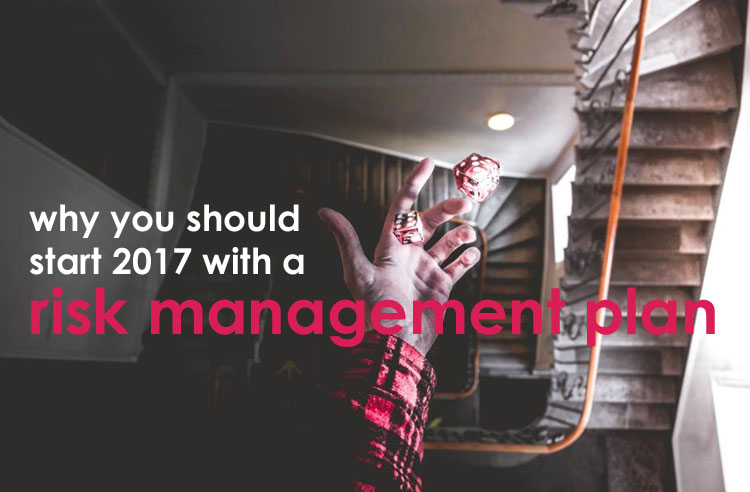
For most of us, the New Year is a time to pursue freshly made personal goals. As a marketer, I think it’s also the perfect time to set new business objectives.
In the wake of 2016, the majority of us are craving a clean start, and what better way to do that then with risk management?
If don’t know much about risk management — or you haven’t conducted it recently — you’re not alone.
An astounding 47 percent of US organizations don’t regularly perform risk assessments, and it’s time we did something about it.
You see, risk is the main cause of organizational uncertainty, and identifying and managing those risks before they affect your business is paramount.
Considering that even giant corporations like Hewlett Packard have watched helplessly as unforeseen risks turned into large-scale financial debacles, small businesses should be on guard. Let’s delve a little deeper into risk — what it is, and why we should be managing it.
What is Risk?
Risk is defined as “a situation involving exposure to danger.” While that’s certainly true, in business, risk is more closely characterized as the probability of an unforeseen incident, and its penalty.
The impact of certain risks can be truly disastrous, affecting an organization’s ability to compete within the industry, maintain financial health, and sustain the quality of products and services. Quite simply, risks are circumstances or factors that damage a business, financially or security-wise.
What Types of Risk Exist?
There are a number of risks that exist in the business world. They can range from uncertainty in financial markets, to natural disasters, to human error.
To simplify things, risk is often divided into internal and external — that is, risks that originate from events taking place within the organization, and risks that originate from events taking place outside the organization.
This list is by no means exhaustive, but it will give you an idea of risks you may face.
Internal Risk
Types of internal risk include:
Human Risks:
- Low employee morale — disgruntled employees can cost money through negligence or intentional acts of sabotage.
- Resignation, illness, or death of key employees or executives
- Employee theft or fraud. Paper timesheets or a decentralized payroll puts you at increased risk for fraud.
- Union strikes
- High turnover
- Ineffective management or leadership
Operational Risks:
- Old equipment that requires constant maintenance.
- Break down of company vehicles.
- Downtime from physical damage or outdated systems.
- Technical failures, such as a server outage.
- Infrastructure problems such as the availability of software and IT support.
- Loss of data due to human error or hacking.
Reputational Risk:
- Loss of a company’s reputation or community standing resulting from product failures, lawsuits, or negative publicity.
- Customers become wary of doing business with you.
- Your employees may decide to leave.
- Hiring good replacements becomes difficult, as potential candidates have heard about your bad reputation.
- Suppliers may start to offer you less favorable terms.
- Advertisers and sponsors no longer want to be associated with you.
External Risk
Types of external risk include:
Market Risks:
- Rising wholesale and raw material costs.
- Rising oil and gasoline prices.
- Emerging technologies that make your product-line obsolete.
- A powerful new competitor entering the market
- Shifts in customer demand.
Compliance Risks:
- Changing laws
- Additional regulations
- Fines for non-compliance
Business Environment Risks:
- Rent increases
- Changing federal, state, county, or city laws and ordinances
- Inclement weather or natural disasters
- Road construction blocking the entrance to your business
As you begin to identify the risks inherent in your business, you’ll need to prioritize and address those which are most likely and will cause the most damage.
Why Risk Management is Important
A well-crafted risk management plan does two things.
- One, it gives management the tools they need to assess risks to the company’s well-being.
- Two, it both controls and applies resources where needed.
The outcome is a better understanding of the company risk profile, and the importance of mitigating said risks.
The rewards of risk management are interconnected in that: Diminished risk leads to better cash flow and stability.
Consequently, creditors see this stability and positive cash flow reflected in your company’s financial reports, and continue to invest in your success. This, in turn, allows your company to expand, and to survive well into the future. Therefore, proper risk management keeps your business profitable and in continuous operation.
Since the risk management process is ongoing, it should be conducted on (at the very least) an annual basis. However, if there has been a substantial change in your company’s risk profile, you should undertake risk management more often — don’t wait for the year mark.
Assessing and managing risks is the best way to safeguard your business and increase its success rate. An effective risk management policy will help you identify the risks before they occur, and put solutions in place to mitigate them. You can’t protect your business from risks you aren’t conscious of, so make it your New Year’s resolution to put a risk management plan at the forefront of this month’s operational goals.
Liz Greene
Latest posts by Liz Greene (see all)
- 5 Things You’re Doing That Turn Millennial Customers Off - December 12, 2018
- 5 Constructive “Parties” to Keep Your Employees Engaged During the Slow Season - November 11, 2018
- 11 Things You Need to Do Before You Hire Your First Employee - November 6, 2018
- 8 Ways Your Small Business Can Get Involved in the Community - September 28, 2018
- 5 Ways to Stop the Spread of Sickness in Your Office - August 27, 2018
